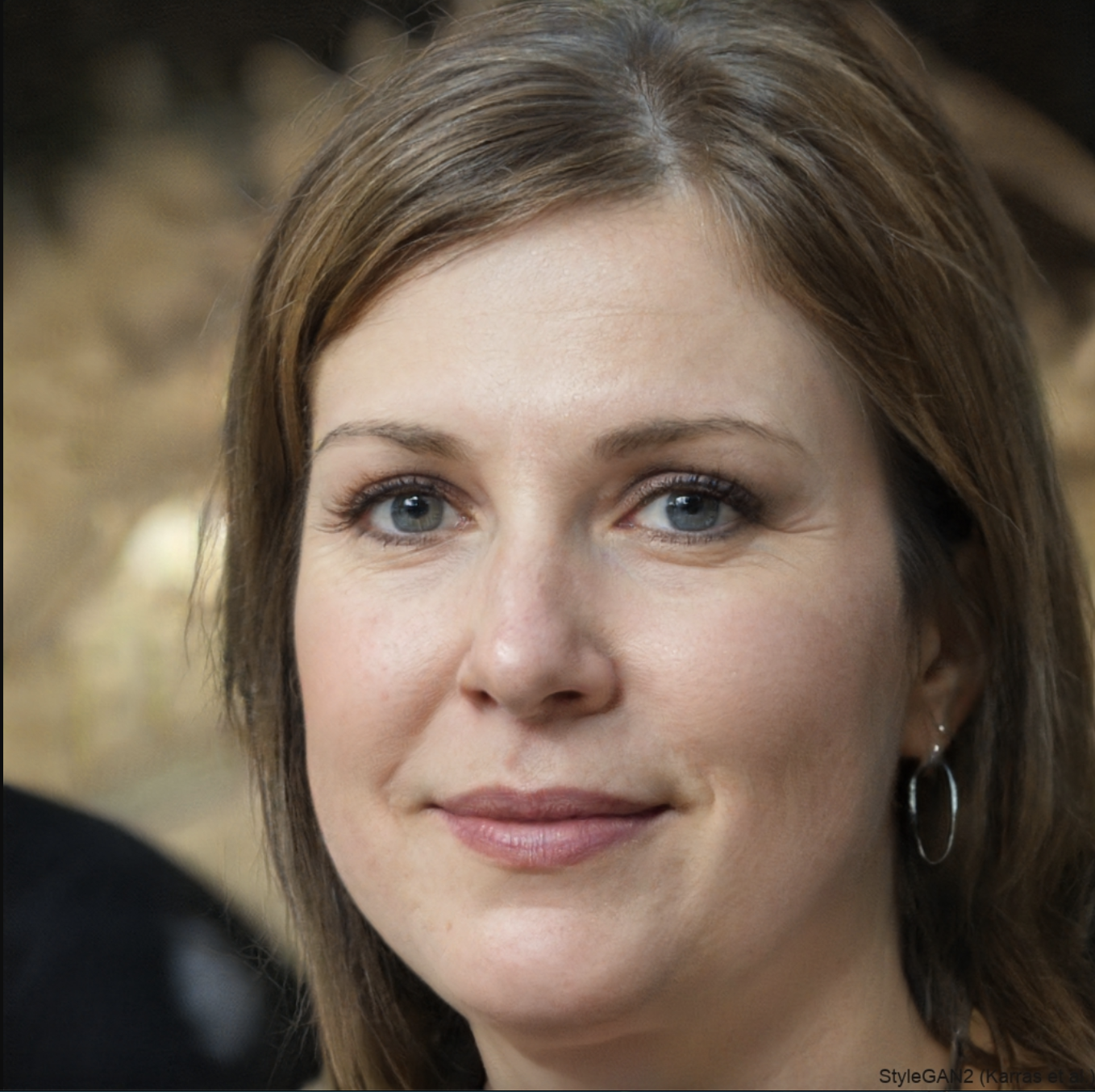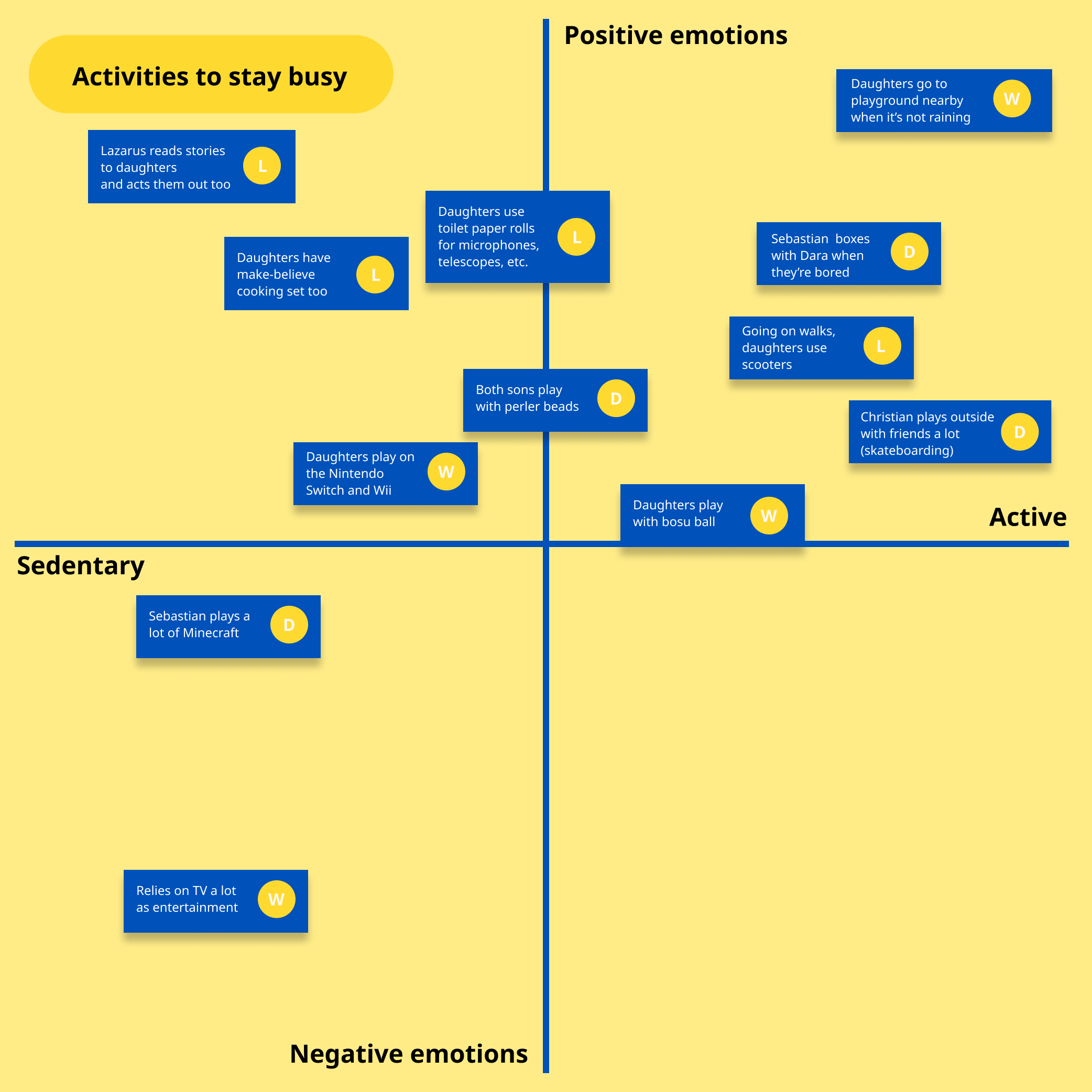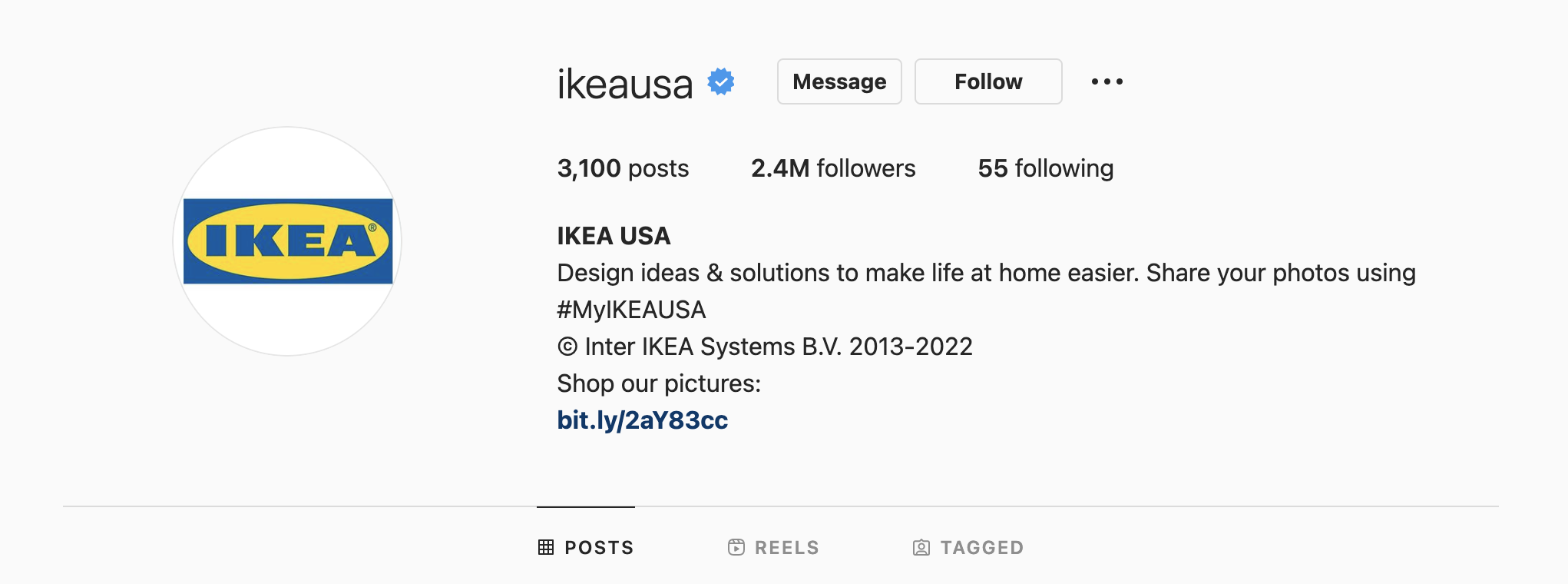IKEA
Background
During my last Winter Quarter at Stanford, I had the pleasure of taking a class called "Needfinding." Throughout the quarter, we learned how to find needs consumers have and solutions for companies that would both solve the consumers' needs and fit the companies' brands. Our final project focused on how IKEA can better cater to parents during the pandemic. We focused on solutions that would best remedy limited space, and constant messes, and encourage parents that toys can bring normalcy to kids.
I worked on designing a marketing strategy to better help IKEA emphasize how toys can bring kids normalcy during COVID-19.
Contributions:
One of three UX Researchers in a shared academic project
Tools Used:
Figma
Adobe Illustrator, Photoshop
Zoom
Duration:
January 2021 - March 2021
The Research
Meet the parents
Our team set out to determine how IKEA might help its customers improve life at home. First, we listened and learned from the parents themselves.
-
A 37-year-old father of three from Blaine, Washington. Wayne has been a remote sales executive for over five years. His oldest currently attends school remotely as well.
When speaking about his daughters' messes, Wayne repeated the phrase, “It is what it is.” Wayne said that he accepts that he can’t prevent his children from making messes – to Wayne, they’re inevitable. He explained that he shoves all his daughter’s toys in a corner of the house and has been doing so since before the pandemic.
-
A 47-year-old mother to two sons, both with learning disabilities. Her sons, who are in middle school, struggle heavily with ADD-related symptoms. Dara, her husband, and her sons live in a “super small condo” (850 sq ft) in Manhattan.
Dara described how little space her apartment has and said, “We have too many Nerf guns and nowhere to put them.” She also said that she recently purchased a new nerf gun for her son. Also, Dara described how she used to have more time to clean up the apartment when her boys were at school, but since the pandemic, “everything has been a mess.”
-
A 39-year-old father of three daughters, aged 7, 4, and 2. Like Wayne, Lazarus’ eldest is learning remotely from home. He rents a two-bedroom condominium with his wife, who works from home.
Lazarus talked about how there was no designated place or method for storing toys in his home. He said that to make more space, he would store toys within other toys. Lazarus said that his family was “outgrowing” the condo and that they did not have enough space for his daughters, or new furniture.
“There’s messes everywhere, I just got frustrated cleaning up every day and putting things away. When I clean up, the kids want to make a mess again.”
Findings
After interviewing the parents, a pattern of peculiar observations stood out across all three participants.
Finding #1
Before the pandemic, parents took a proactive approach to clean their children’s messes. After the pandemic, parents say they no longer make an effort to organize and that “it is what it is.”
IKEA designed for before the pandemic, but these findings indicate a change in the mindset of parents and new needs that are currently unaccounted for by IKEA.
These findings indicate a change in the mindset of parents and new needs that are currently unaccounted for by IKEA.
Finding #2
Parents keep buying more toys even though they say they don’t have any more space for more toys.
Insights
What makes these findings make sense? What explains the parents’ bizarre behavior? Our team came up with insights, backed by data, to clarify the interviewee’s behavioral motivations.
Parents are taking a much more passive approach to clean their children’s messes during COVID.
Lazarus and Dara said that they made constant attempts at cleaning their children’s messes before and at the beginning of the pandemic but said they became frustrated as the pandemic wore on and eventually stopped trying to clean. Wayne described himself as a “hands-off” organizer since the beginning of the pandemic but has been working remotely for five years, which supports the hypothesis that working from home correlates with a decrease in proactive cleaning.
Parents feel bad for their kids during COVID-19 (and this guilt increases as the pandemic continues), using more toys as compensation.
Parents feel bad that their kids aren’t able to have the childhood they imagined their kids to have during COVID: Dara, Wayne, and Lazarus all mentioned that their kids weren’t able to get outside as much, with Wayne, in particular, stating that he wished his kids got out more, but because of the weather, it is often not nice enough for them to go outside. If they do, they “track in a bunch of mud and make a mess,” which causes Wayne “a headache.” Wayne said he purchased toys that he had when he was a kid or wished he had. Lazarus also mentioned that he was strict about keeping his daughters inside as much as possible due to COVID and kept buying them DIY crafts despite also stating that his family was “outgrowing” the condo, that they had very little space, and he was planning on moving soon to a bigger place.
Toys are the way parents are compensating in part because they view toys as fun yet healthy alternatives to screen time: Wayne said that “TV is a great way to keep kids entertained” but says that he discourages too much TV because it’s “not good for them.” Dara said that screen time “fries” her kids’ brains and that she keeps buying them Nerf guns, even though she says she doesn’t have space for them in their “tiny” apartment.
Needs
What makes these findings make sense? What explains the parents’ bizarre behavior? Our team came up with insights, backed by data, to clarify the interviewee’s behavioral motivations.
Parents have dozens of surface-level needs: they need to have a babysitter, the need to drop their child off on time, the need to make dinner. But, ultimately, parents need to be happy, to feel comfortable in a space, and to feel mentally stable/at peace. These are needs that are common for most people, whether you’re a parent or not, but these are far too broad to solve. In order to come up with interesting solutions, we need to keep asking “how?”
Diving deeper, parents need to prevent messes from occurring and need to be able to easily organize their home in order to be happy. This can create a clean environment while helping families grow closer. They also need to create privacy in their homes. Parents share their home with one or more people, so they need to feel a sense of belonging in that space. Also, parents need to occupy others in order to work in a quiet environment and focus to feel at peace.
Where do we go from here?
Children are at the top of parents’ priorities, often sacrificing time, money, and well-being to support their kin. With our findings and insights in mind, we can begin to brainstorm solutions for parents’ needs of privacy, happiness, and focus. Overall, parents want what’s best for their kids. The ideal product should make parents’ lives easier but also make them feel like they’re still great parents.
IKEA is all about life from home and constantly looks for better ways to improve everyday life. IKEA strives “to provide well-designed, functional home furnishings at prices so low that as many people as possible will be able to afford them.” Their low prices are the result of IKEA saving on labor costs. They are often known for having Do-It-Yourself furniture, allowing customers to assemble their purchases themselves.
Merge furniture functionality to maximize space so that parents can easily organize.
Create products to prevent kids from creating messes in the first place so that parents worry less and clean less.
Emphasize to parents the increased importance of toys for kids during COVID to help them feel like they can give their child an active, fulfilling childhood.
Design Principles
In line with IKEA’s mission and the needs of parents, our design principles will lead to the best solutions for both parties. These principles are broad enough to allow our team to come up with the most unique and interesting solutions, while also sticking to IKEA’s brand.
Solutions
Our team came up with a system of solutions that, together, will bring IKEA to the next level via adaptive positioning. The following design strategies will help IKEA differentiate from their competition by building an online presence which will be utilized to establish IKEA as an innovator of multi-functional, detachable, family-friendly furniture. If IKEA wants to thrive post-COVID, in which online shopping/marketing reigns supreme over in-person practices, it must position itself at the forefront of the most formidable digital age yet.
Normal Never Left
A marketing campaign emphasizing how toys can bring kids normalcy during COVID-19.
Competition
IKEA needs to appeal to parents in more ways than just selling inexpensive furniture. As more millennials become parents, they turn to the internet to answer their questions. IKEA’s social media presence has been fairly quiet in recent years, averaging about 4K likes per Instagram post versus their competitor, Target, who rakes in 40K likes per Instagram post.
Normal Never Left
IKEA has to have a better online presence during this digital age of work from home and Zoom school. They can reach another generation of parents and ultimately emphasize how it is possible for their child to have a normal childhood during this uncertain time. YouTube is a great platform to start on because it is filled with the best guidance on nearly every topic one can think of. Eye-catching titles can boost interactions and likes.
Toys have been a constant during the pandemic. Many childhood experiences, like going to Disneyland or going to the park with friends, are no longer accessible with COVID restrictions. Therefore, IKEA needs to emphasize how normal hasn’t left towards parents online.











